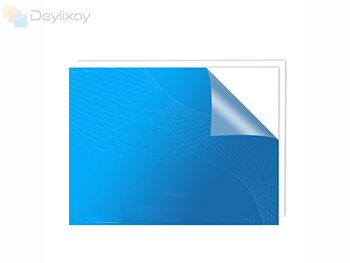إذا كنت تنغمس في مشروع DIY، أو تبني علبة عرض، أو حتى تفكر في إنشاء حاجز وقائي جديد، فمن المحتمل أنك واجهت المصطلحين "ورقة أكريليك" و"ورقة زجاج شبكي". ربما تكون قد استخدمتها بالتبادل. وهذا يؤدي إلى سؤال شائع ومربك: هل هما مختلفان بالفعل؟

الجواب القصير هو نعم ولا. تعد العلاقة بين الأكريليك وزجاج شبكي مثالًا كلاسيكيًا لاسم العلامة التجارية مقابل مصطلح عام. دعونا نزيل الارتباك مرة واحدة وإلى الأبد.
جوهر المسألة: اسم العلامة التجارية مقابل اسم المادة
فكر في الأمر بهذه الطريقة: كل زجاج شبكي مصنوع من الأكريليك، ولكن ليس كل الأكريليك مصنوع من زجاج شبكي.
الأكريليك: هذا هو الاسم العالمي للمادة نفسها. علميًا، إنه بوليمر صناعي يسمى بولي ميثيل ميثاكريلات (PMMA). وهو نوع من البلاستيك المتين والشفاف المعروف بوضوحه وقوته ومقاومته للعوامل الجوية. "ورقة الأكريليك" هي المصطلح العام للمنتجات المصنوعة من هذه المادة، تمامًا مثل "أنسجة الوجه" وهي فئة عامة من المنتجات.
Plexiglass®: هذا اسم تجاري محدد لألواح الأكريليك، تم تطويره في الأصل ووضع علامة تجارية عليه من قبل شركة الكيماويات Röhm (التي أصبحت الآن جزءًا من Altuglas International). كانت واحدة من أوائل الشركات التي قامت بتسويق أوراق PMMA تجاريًا في أمريكا الشمالية، وأصبح اسمها شائعًا جدًا لدرجة أنه تحول إلى مصطلح منزلي لجميع الأغطية البلاستيكية الشفافة، مثل "Kleenex" للأنسجة أو "Band-Aid" للضمادات اللاصقة.
لذا، فإن "الفرق" الأساسي هو ببساطة الاختلاف في العلامة التجارية. عندما تطلب زجاج شبكي، فأنت تطلب في الأساس لوح أكريليك يحمل علامة تجارية.
هل هناك أي اختلافات فعلية في المنتجات؟
في حين أن المادة الأساسية (PMMA) هي نفسها، إلا أنه لا يتم إنشاء جميع صفائح الأكريليك على قدم المساواة. وهنا يأتي دور الاختلافات المتصورة. تنتج الشركات المصنعة المختلفة صفائح الأكريليك بدرجات مختلفة:
الجودة والنقاء: غالبًا ما تخضع صفائح الأكريليك عالية الجودة، من العلامات التجارية المشهورة مثل Plexiglas® أو Polycast أو Lucite®، لعمليات تصنيع أكثر دقة. يمكن أن يؤدي ذلك إلى وضوح بصري فائق، ومقاومة أفضل للاصفرار الناتج عن التعرض للأشعة فوق البنفسجية، وتقليل العيوب الداخلية مثل الفقاعات أو الشوائب.
عملية التصنيع: يتم تصنيع صفائح الأكريليك بشكل أساسي من خلال إحدى طريقتين: صب الخلايا أو البثق.
عادةً ما يكون أكريليك Cell Cast (الطريقة المستخدمة غالبًا في Plexiglas®) أكثر صلابة، وله وزن جزيئي أعلى، ويوفر جودة بصرية ممتازة وصلابة سطحية. كما أنه أكثر مقاومة للمواد الكيميائية وأسهل في التصنيع (المنشار والحفر والتلميع) دون أن يتشقق.
الأكريليك المبثوق عبارة عن عملية مستمرة تؤدي إلى ورقة أكثر مرونة بسمك ثابت. إنها بشكل عام أقل تكلفة ولكنها قد تكون أكثر عرضة للتشقق أثناء التصنيع وقد لا تكون مقاومة للمواد الكيميائية.
لذلك، من المحتمل أن تكون الورقة المباعة على أنها "زجاج شبكي" عبارة عن أكريليك مصبوب عالي الجودة. ومع ذلك، يمكنك أيضًا العثور على علامات تجارية وألواح عامة أخرى تكون أيضًا مصبوبة خلويًا وذات جودة مماثلة.
أوجه التشابه الرئيسية بين الاكريليك وزجاج شبكي
نظرًا لأن زجاج شبكي هو نوع من الأكريليك، فإنه يشترك في نفس الخصائص المفيدة:
وضوح بصري عالي: كلاهما يسمح بمرور حوالي 92% من الضوء، مما ينافس الزجاج.
خفيفة الوزن: حيث يبلغ وزنها حوالي نصف وزن الزجاج من نفس الحجم.
مقاومة الصدمات: فهي أكثر مقاومة للصدمات بمقدار 10 إلى 20 مرة من الزجاج، مما يجعلها بديلاً أكثر أمانًا.
مقاومة الطقس: يتمتع كلاهما بمقاومة ممتازة للعناصر والأشعة فوق البنفسجية، مما يمنع الاصفرار والتدهور بمرور الوقت.
سهولة التصنيع: فهي أسهل بكثير في القطع والحفر والتشكيل من الزجاج.
أيهما يجب أن تختار لمشروعك؟
لا ينبغي أن يكون اختيارك متعلقًا باسم "أكريليك" مقابل اسم "زجاج شبكي"، بل يتعلق بمواصفات الورقة التي تشتريها.
للتطبيقات المتطورة: إذا كنت بحاجة إلى أفضل وضوح بصري على الإطلاق، ولمسة نهائية فائقة للسطح، وأقصى قدر من المتانة لمشروع احترافي (مثل عرض المتحف، أو اللافتات المتطورة، أو حوض السمك)، فابحث عن الأكريليك المصبوب الخلوي. يمكن أن يكون هذا هو اسم العلامة التجارية Plexiglas® أو منتج صب خلوي آخر لمورد حسن السمعة.
للاستخدام المنزلي والاستخدام المنزلي العام: بالنسبة للمشروعات مثل إطارات الصور، أو الحرف اليدوية البسيطة، أو الأرفف الصغيرة، أو ألواح النوافذ الواقية، ستكون ورقة الأكريليك القياسية المبثوقة أكثر فعالية من حيث التكلفة وملائمة تمامًا. إنه متاح على نطاق واسع في متاجر تحسين المنزل.
تحقق من المواصفات: انظر دائمًا إلى ما هو أبعد من الملصق. تحقق من ورقة البيانات بحثًا عن خصائص مثل:
مقاومة التأثير (تصنيف IZOD)
نفاذية الضوء (٪)
تثبيت الأشعة فوق البنفسجية (إذا كان للاستخدام الخارجي)
التسامح سمك
الحكم النهائي
الفرق الحقيقي بين الأكريليك والزجاج شبكي هو التسويق وليس المادة. زجاج شبكي هي ببساطة علامة تجارية مشهورة لألواح الأكريليك. عند التسوق، ركز بشكل أقل على الاسم العام وأكثر على النوع المحدد (المصبوب مقابل المبثوق)، ودرجة الجودة، وسمعة الشركة المصنعة. من خلال فهم هذا التمييز، يمكنك اتخاذ قرار أكثر استنارة واختيار الأغطية البلاستيكية الشفافة المثالية لإضفاء الحيوية على مشروعك.
 English
English Español
Español Portugues
Portugues Pусский
Pусский Français
Français Deutsch
Deutsch 日本語
日本語 한국어
한국어 Italiano
Italiano Nederlands
Nederlands Ελληνικά
Ελληνικά Svenska
Svenska Polski
Polski ไทย
ไทย Türk dili
Türk dili हिन्दी
हिन्दी Indonesia
Indonesia Melayu
Melayu Tiếng Việt
Tiếng Việt dansk
dansk Magyar
Magyar қазақ
қазақ বাংলা
বাংলা עִברִית
עִברִית မြန်မာ
မြန်မာ українська
українська norsk
norsk Gaeilge
Gaeilge Română
Română ພາສາລາວ
ພາສາລາວ Filipino
Filipino Suomalainen
Suomalainen slovenský
slovenský o'zbek
o'zbek Igbo
Igbo Hrvatski
Hrvatski Zulu South Africa
Zulu South Africa Afrikaans isiXhosa
Afrikaans isiXhosa lëtzebuergesch
lëtzebuergesch тоҷикӣ
тоҷикӣ नेपाल
नेपाल Eesti
Eesti Yoruba
Yoruba Монгол
Монгол ខ្មែរ
ខ្មែរ 中文(繁体)
中文(繁体) Afrikaans
Afrikaans












 هاتف
هاتف
تعليق
(0)